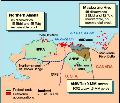What's happening in exploration
ANWR study used to support all viewpointsThe 1.5 MM-acre section 1002 area, established in 1980 by the Alaska National Interest Lands Conservation Act, lies about 80 mi east of Prudhoe Bay. The U.S. Geological Survey (USGS) initiated the three-year study for possible oil development in the Arctic National Wildlife Refuge; its estimate of in-place resources ranged from a 95% probability that there are greater than 11.6 Bbbl, to a 5% chance there are more than 31.5 Bbbl. A decade ago, amid much controversy concerning the methods employed, the estimates were 4.8 and 29.4 Bbbl (95% and 5% probabilities). The upward estimate of undiscovered resources relied on reprocessing older seismic data, information from several adjacent exploration wells and known fields, and new geological data. The American Association of Petroleum Geologists (AAPG), which supports exploration of the area, endorsed the scientific methodology and procedures used to assess the oil and gas resources. Results were not released to AAPG during its review, only the methodologies.
Using recovery factors and cost estimates, the USGS extrapolates the above in-place resources into technically recoverable oil, and then into economically recoverable oil. Technically recoverable oil, currently estimated at 4.3 to 11.8 Bbbl, is the amount recoverable using current technology; a number sure to grow as technology improves. Finally, according to USGS, none of the oil is economically recoverable at a market price below about $15/bbl; but at $20/bbl, roughly 3.2 Bbbl are profitable. In addition, these amounts appear to occur in numerous accumulations, the largest of these in the 1 to 2 Bbbl range, and one or two in the 500 MM to 1 Bbbl range, according to Dave Houseknecht, energy resource program coordinator for the three-year, $4-million study. Whether any oil will be recovered is not a technical matter, but a political one, with all sides using the same data to justify their position. Interior Secretary Bruce Babbit said that since the report indicates numerous small reservoirs, it would require "the kind of infrastructure that would forever and drastically alter the landscape." However, Alaska Sen. Frank Murkowski said the study helps justify new seismic testing to confirm even larger deposits in the refuge area. "These numbers show once again that this area of Alaska is still the single best prospect in America to explore for oil," said Murkowski. In usual Clintonesque fashion, perhaps a compromise could be in the offing. Surely, a 1 to 2-billion-bbl accumulation is nothing to pass up, and the handful of wells necessary to delineate the reservoir would not unduly harm the black flies. New gas trend. Chevron announced discovery of a new gas trend in the Gulf of Mexico offshore Mississippi. Known as the Viosca Knoll Carbonate Trend, it is not a new area for exploration, but the magnitude and extent of the trend, especially in such a mature area, is exciting. Chevron drilled 15 exploratory wells since 1990 in the shallow 120-ft waters, located about 25 mi south of Pascagoula, Mississippi. Even more surprising, Chevron was able to keep the discovery quiet while it acquired a hefty 350,000 acres consisting of 76 blocks, the largest lease concentration on the shelf. The company made five gas discoveries on five leases: Mobile Block 991 and Viosca Knoll Blocks 68, 114, 251 and 252. Pay thickness ranged from 35 to 115 feet from two Lower Cretaceous reservoirs in the James Formation. This is the first time this particular geologic age has produced in the Gulf. Viosca Knoll is contiguous to and lies due south of the giant Norphlet natural gas trend, which contains about 9 Tcf of gas. Chevron estimates a recoverable reserve potential of 600 Bcf from the five discoveries, located along 40 mi of the trend. However, the trend continues perhaps another 50 mi, increasing the company’s estimate to 1 Tcf for the entire trend. "But we really don’t know," says Steve Thurston, manager of Chevron’s business unit. "We have some wells planned for the next year and the year after, and that could tell us the true number." First VSP recorded in a horizontal well on wireline. CGG’s Borehole Services Division, on behalf of Esso Norge A/S, has acquired what it believes is the first vertical seismic profile (VSP) recorded in a truly horizontal well as a conventional wireline service. The data was recorded in a deviated well with a 720-m horizontal section in the Balder field in the Norwegian sector of the North Sea. The maximum borehole angle reached 95°. CGG’s technology, known as Pipeseis, uses an ultra-slim three-component geophone
system pumped down through drill pipe. A 70-level deviated well VSP, using both rig and boat
sources, was recorded in less than half the time expected by the operating company,
according to CGG. Copyright © 1999 World
Oil |




